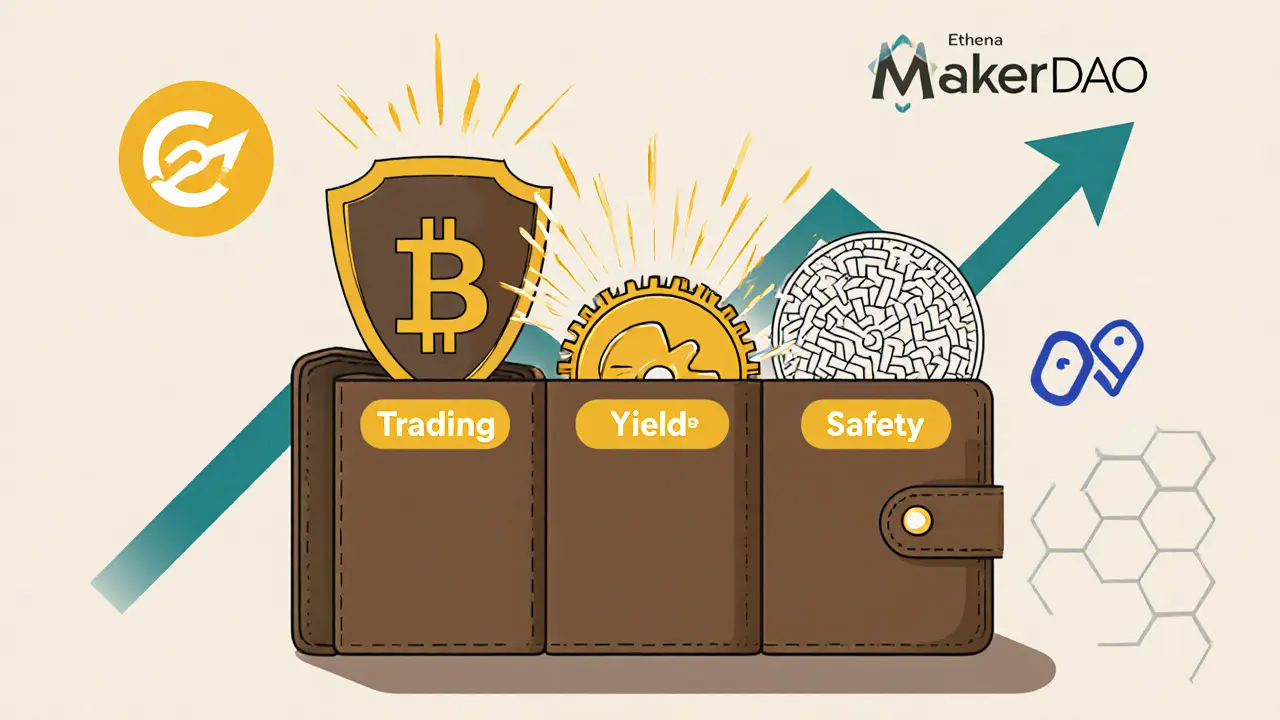When you're trading crypto or diving into DeFi, your stablecoin isn't just a placeholder-it's your anchor. Pick the wrong one, and you could lose money to slippage, frozen funds, or a protocol collapse. Pick the right one, and you’ll move in and out of trades smoothly, earn yield without selling your assets, and stay safe when the market turns sour. In 2025, the stablecoin landscape isn’t what it was five years ago. The days of blindly trusting any coin pegged to the dollar are over. Now, you need to know how it’s backed, who controls it, and where it works best.
USDC: The Liquidity King for Trading
If you’re trading on Binance, Coinbase, or Kraken, USDC is probably the first stablecoin you see. It’s the most liquid. It’s the one with the tightest spreads. When you’re moving $50,000 in and out of positions, slippage under 0.05% is common with USDC. That’s because exchanges prioritize it. It’s backed 1:1 by U.S. dollars and short-term Treasuries, audited monthly by Grant Thornton. That transparency matters-especially after Tether’s past controversies.
But here’s the catch: Circle, the company behind USDC, can freeze addresses. In 2023, they blocked funds tied to a sanctioned wallet. In 2025, they froze $200 million in a single DeFi protocol after a regulatory request. If you’re using USDC in a decentralized exchange like Uniswap and your wallet gets flagged, you’re stuck. No appeal. No recovery. For traders who need speed and liquidity, USDC is unbeatable. For anyone who values true decentralization, it’s a liability.
DAI: The Decentralized Workhorse of DeFi
DAI is the only stablecoin that doesn’t rely on a company. It’s created by MakerDAO, a decentralized autonomous organization (DAO) governed by MKR token holders. To mint DAI, you lock up crypto-like ETH or BTC-as collateral, at least 150% of the DAI you want. If ETH drops 30%, your collateral gets liquidated. If it rises, you can withdraw extra. It’s automated, transparent, and has survived multiple crypto crashes since 2017.
DAI is the backbone of DeFi. It’s accepted on over 400 protocols-from Aave and Compound to Curve and SushiSwap. When you’re lending, borrowing, or farming yield, DAI is often the default. It trades slightly above $1 during high demand, and sometimes dips to $0.98 during panic sell-offs. But it always snaps back. Why? Because arbitrage bots jump in the second it depegs. There’s no central authority to fix it-just code and incentives.
DAI isn’t perfect. If you’re new to DeFi, minting it requires understanding collateral ratios and liquidation risks. But if you’re just buying and holding it? That’s as simple as buying any other token. And unlike USDC, no one can freeze your DAI. That’s why institutional DeFi players still prefer it for long-term positions.
USDe: The Yield-Generating Game Changer
USDe, launched by Ethena in early 2024, changed the game. It’s not backed by dollars. It’s backed by Ethereum and perpetual futures contracts. Here’s how it works: You stake ETH. Ethena uses that ETH to sell futures contracts that hedge against price swings. The profit from those trades? That’s what keeps USDe pegged to $1-and pays you 8-15% APY.
In 2025, USDe has over $8 billion in circulation. It’s integrated into Aave, Curve, and Convex Finance. Yield farmers are flocking to it because it’s one of the few stablecoins that actually pays you for holding it. No need to lend it out. No need to stake it. Just hold USDe in your wallet, and you earn.
But here’s the risk: It’s complex. If Ethereum’s price crashes hard and the futures hedge fails, USDe could depeg. It’s never happened-yet. But it’s a new mechanism, and DeFi’s history shows new models often break under stress. Most experts recommend starting with small amounts. Use it for yield farming, not as your primary savings. Don’t put your life savings in USDe. Put 10-20% of your stablecoin holdings there. The rest? Keep it in DAI or USDC.

FRAX: The Hybrid Middle Ground
FRAX is a hybrid. It’s part collateralized (mostly USDC), part algorithmic. Originally, it was 100% algorithmic-like TerraUSD. After UST collapsed in 2022, FRAX changed. Now it’s 70-90% collateralized, depending on market conditions. That makes it more stable than pure algorithmic coins, but more decentralized than USDC.
FRAX offers around 5-7% APY through its liquidity pools and staking. It’s not as liquid as USDC or DAI, but it’s growing fast. You’ll find it on Uniswap, Curve, and Balancer. It’s a good option if you want yield without the complexity of USDe, and you don’t trust centralized issuers.
FRAX doesn’t have the brand recognition of DAI or USDC, but it’s quietly becoming the stablecoin for privacy-focused traders and DeFi purists who want a middle path. It’s not the safest, but it’s not the riskiest either.
USDT: The Legacy Player with Lingering Doubts
Tether (USDT) still dominates by volume. It’s on every exchange. It’s the most traded stablecoin globally. But its transparency is shaky. Tether claims to be fully backed, but it doesn’t do monthly audits like Circle. Instead, it releases occasional attestations from third parties. In 2021, they admitted to holding commercial paper and other risky assets. That scared a lot of people.
USDT is still the go-to for traders who need maximum liquidity on non-U.S. exchanges. But if you’re serious about DeFi, you’ll avoid USDT in lending protocols. Most platforms like Aave and Compound don’t accept it as collateral. Why? Because of the trust issues. If you’re just buying and selling on Binance, USDT is fine. If you’re building a DeFi strategy? Keep it out.

Which One Should You Use?
There’s no single answer. The best strategy is to use multiple stablecoins based on what you’re doing.
- For trading on centralized exchanges: Use USDC. It’s the fastest, most reliable.
- For DeFi lending, borrowing, and yield farming: Use DAI. It’s decentralized, battle-tested, and accepted everywhere.
- For earning yield without active management: Try USDe. Allocate no more than 20% of your stablecoin holdings here.
- For a hybrid, semi-decentralized option: Use FRAX if you want yield and decentralization without the complexity of synthetic assets.
- Avoid USDT in DeFi. Keep it for quick trades on non-U.S. platforms only.
Advanced users are starting to use cross-chain bridges to move stablecoins between Ethereum, Polygon, and Arbitrum. Symbiosis Finance and LayerZero make this easy now-swaps take less than a minute, with clear fee estimates. But always check the bridge’s security record. Some have been hacked.
What to Watch in 2026
MakerDAO is transitioning to a new system called Sky, which will make DAI even more efficient and reduce collateral requirements. If it works, DAI could become even more dominant.
Ethena’s USDe is expected to hit $15 billion in circulation by early 2026. If it does, synthetic stablecoins will no longer be a niche-they’ll be a mainstream alternative to fiat-backed coins.
And regulators? The EU’s MiCA rules are already pushing exchanges to favor compliant stablecoins like USDC. The U.S. is drafting its own rules, expected in 2026. That could force Tether to become more transparent-or lose market share.
Bottom line: Stablecoins are no longer just about being pegged to the dollar. They’re about trust, yield, and decentralization. The best one for you depends on what you’re trying to do. Don’t pick one and stick with it. Adapt. Diversify. Stay informed.
Which stablecoin is safest for long-term DeFi holding?
DAI is the safest for long-term DeFi holding because it’s fully decentralized, has no central authority that can freeze funds, and has survived multiple crypto crashes since 2017. While it can temporarily depeg during market stress, it always returns to $1 due to arbitrage. Unlike USDC or USDT, no company controls it.
Can I earn interest just by holding USDe?
Yes. USDe pays yield automatically just by holding it in your wallet. The Ethena protocol generates yield through delta-neutral futures strategies and distributes it to USDe holders. As of 2025, yields range from 8% to 15% APY, making it one of the few stablecoins that earns passive income without requiring you to stake, lend, or provide liquidity.
Why is USDC better than USDT for DeFi?
USDC is better than USDT for DeFi because it’s backed by transparent, monthly audits from Grant Thornton, and it’s widely accepted as collateral in DeFi protocols like Aave and Compound. USDT lacks consistent transparency and is often excluded from lending platforms due to its opaque reserve structure. USDC also has better regulatory compliance, making it more trusted by institutions.
Is FRAX a good alternative to DAI?
FRAX is a good alternative if you want yield and partial decentralization without the complexity of minting DAI. It’s backed mostly by USDC but has algorithmic elements that adjust its collateral ratio. It offers 5-7% APY and works well on DeFi platforms like Uniswap and Curve. However, it’s not as battle-tested as DAI and still relies on centralized assets for part of its backing.
Should I avoid algorithmic stablecoins entirely?
Yes, avoid purely algorithmic stablecoins like the old TerraUSD (UST). They rely on complex incentives and market demand to maintain their peg, and when confidence drops, they can collapse instantly. FRAX and USDe are not purely algorithmic-they use collateral or synthetic hedging. Stick to those. Avoid any stablecoin that claims to be 100% algorithmic without any asset backing.
What’s the best way to swap between stablecoins?
Use Curve Finance for swapping between stablecoins like USDC, DAI, FRAX, and USDe. Curve is optimized for low-slippage trades between assets with similar values. Slippage is typically under 0.1% for trades up to $100,000. For cross-chain swaps, use Symbiosis Finance or LayerZero-they’re fast, transparent, and support major stablecoins across Ethereum, Polygon, and Arbitrum.

Becky Shea Cafouros
November 13, 2025 AT 21:02USDC is fine for trading but if you’re holding long term you’re basically trusting a corporation not to get pressured by the Fed. DAI is the only real option if you care about autonomy.
Drew Monrad
November 14, 2025 AT 11:30Y’all are acting like DAI is some sacred temple of decentralization when it’s just a glorified margin call machine. If ETH drops 40% overnight, your entire portfolio gets liquidated and you’re left holding dust. USDC freezes your wallet? At least you still have money. DAI just turns your life into a trading simulator.
sandeep honey
November 15, 2025 AT 19:54Why is everyone ignoring FRAX? It’s the real sweet spot-DAI’s stability with USDC’s liquidity and a little algorithmic spice. Plus, 7% APY just for holding? That’s free money if you’re not greedy.
Mandy Hunt
November 17, 2025 AT 14:33USDe is a ponzi scheme wrapped in blockchain jargon. Ethena is just printing money by betting against ETH and calling it yield. When the next crash hits, they’ll vanish like Terra and leave everyone with worthless tokens. They’re not stable-they’re just pretending to be
anthony silva
November 18, 2025 AT 10:18USDC is the new Tether. Same company, different logo. They freeze wallets like they’re playing Tetris with your life savings. If you’re not paranoid, you’re not paying attention.
David Cameron
November 19, 2025 AT 04:22Stablecoins aren’t about stability anymore. They’re about who controls the narrative. USDC says ‘trust us’ with audits. DAI says ‘trust code’ with collateral. USDe says ‘trust math’ with futures. But who trusts the trusters? That’s the real question.
Kandice Dondona
November 20, 2025 AT 00:25Love this breakdown!! 🙌 I’ve been using DAI for DeFi and USDC for trading and it’s been a game-changer. USDe is tempting with that yield but I’m keeping it under 15% like the post says-no way I’m risking my whole stack on something that needs a PhD to understand 😅
Cody Leach
November 21, 2025 AT 21:03FRAX is underrated. It’s not flashy like USDe but it’s the quiet kid in class who always gets the A. I’ve held it for 8 months and it’s never deviated more than 0.3%. Perfect for passive holders who don’t want to babysit collateral ratios.
Cherbey Gift
November 23, 2025 AT 00:53Stablecoins are the new religion and we’re all worshiping different gods. DAI is the monk, USDC is the CEO, USDe is the cult leader with a shiny whitepaper and a 15% promise. Choose your deity wisely-or better yet, don’t worship at all. Just hold Bitcoin and laugh at the chaos.
Anthony Forsythe
November 24, 2025 AT 12:19Think about it: every stablecoin is a compromise. USDC sacrifices decentralization for liquidity. DAI sacrifices convenience for sovereignty. USDe sacrifices safety for yield. FRAX sacrifices purity for pragmatism. And USDT? USDT is the ghost haunting every crypto conversation-present but never truly accepted. We’re not choosing coins. We’re choosing our values.
Sara Lindsey
November 26, 2025 AT 10:52Just started using USDe and it’s wild how easy it is to earn 12% just sitting there. I didn’t even know I needed this until I tried it. My wallet’s been sleeping and now it’s making money. Game changer.
alex piner
November 28, 2025 AT 09:16DAI is the real MVP. I used to use USDC cause it was easy but then I lost access to my wallet for 3 days during a freeze and I was like nah. DAI doesn’t care who you are. It just works. No drama. Just crypto.
Gavin Jones
November 30, 2025 AT 05:29For those unfamiliar with cross-chain swaps, LayerZero’s fee structure is far more predictable than Symbiosis. Also, always test with small amounts first. I lost $47 to a bridge glitch in 2023. Never again.
Mauricio Picirillo
December 1, 2025 AT 10:02Big up to the author for calling out USDT properly. I used to use it on Binance because it was everywhere but now I avoid it like a bad ex. USDC and DAI are the only ones I trust in DeFi. Simple.
Liz Watson
December 3, 2025 AT 08:42FRAX? You’re telling me to trust a stablecoin that’s 70% USDC? That’s like calling a Tesla an electric bicycle because it has wheels. You’re just buying a wrapped dollar with extra steps. Save yourself the gas fees.
Rachel Anderson
December 4, 2025 AT 04:40USDe is the future. The fact that you’re still debating DAI vs USDC in 2025 shows how stuck in the past you are. Yield-bearing stablecoins are the new standard. If you’re not earning, you’re losing.
Hamish Britton
December 5, 2025 AT 01:15Just want to say this post is one of the clearest breakdowns I’ve seen. No fluff, no hype. Just facts. I’ve shared it with my crypto study group. Thanks for doing the work.
Albert Melkonian
December 6, 2025 AT 21:58It's worth noting that the transition of MakerDAO to Sky will significantly reduce the collateralization ratio from 150% to approximately 110%, which will increase capital efficiency without compromising stability. This evolution may solidify DAI's position as the dominant DeFi stablecoin for institutional adoption.
Kelly McSwiggan
December 7, 2025 AT 00:04USDC’s monthly audits? Please. Grant Thornton doesn’t audit the underlying assets-they audit the ledger. There’s a difference between ‘paper-backed’ and ‘actually liquid.’ The moment the Fed panics, USDC becomes a digital ghost. DAI at least has code on its side.
Byron Kelleher
December 8, 2025 AT 05:37Everyone’s so scared of USDe but honestly? It’s just the next step. Every new tech looks like a gamble until it works. I put 10% in and it’s been smooth. If it crashes, I lose a tenth. If it wins, I win big. That’s crypto.